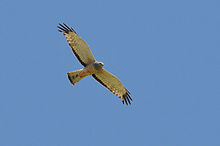- Cinereous Harrier
-
Cinereous Harrier 
Male flying in Rio Grande do Sul, Brazil Conservation status Scientific classification Kingdom: Animalia Phylum: Chordata Class: Aves Order: Falconiformes
(or Accipitriformes, q.v.)Family: Accipitridae Genus: Circus Species: C. cinereus Binomial name Circus cinereus
(Vieillot, 1816)The Cinereous Harrier (Circus cinereus) is a South American bird of prey of the harrier family. Its breeding range extends from the Tierra del Fuego through Argentina and Chile to Bolivia, Paraguay and southern Brasil; and across the Andes north to Colombia.
The term cinereous describes its colouration. The male's plumage is dark grey above with black wingtips and a white rump. The underparts are pale grey, with a rufous streaked belly. The female's plumage is brown above, with a white rump, and cream coloured underneath, with a streaked belly similar to the males. The female is larger than the male with an average size of 46 cm (18 in) compared to the male's 40 cm (16 in). The wingspan is 90–115 cm (35–45 in). Since the 44.5 cm (17.5 in) tail comprises about 56% of this raptor's total length, this species ties with the Long-tailed Hawk as the raptor with the longest tail relative to its body size.[1]
This bird can be found in different open habitats, ranging from lowland marshes to the Andean Altiplano at a maximum altitude of 4500 metres. Like other harriers it nests on the ground. It is usually considered to be sedentary.
Its diet is variable, due to a wide range and variety of habitats. Its usual prey are small rodents and birds, reptiles, amphibians and insects.
References
- ^ Raptors of the World by Ferguson-Lees, Christie, Franklin, Mead & Burton. Houghton Mifflin (2001), ISBN 0-618-12762-3
- BirdLife International (2004). Circus cinereus. 2006. IUCN Red List of Threatened Species. IUCN 2006. www.iucnredlist.org. Retrieved on 11 May 2006. Database entry includes justification for why this species is of least concern

This Falconiformes article is a stub. You can help Wikipedia by expanding it.

